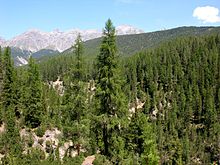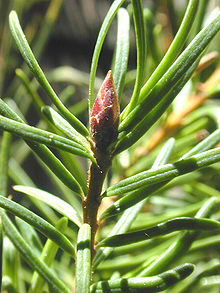 A conifer forest in the Swiss Alps (National Park)
A conifer forest in the Swiss Alps (National Park)The conifers, division Pinophyta, also known as division Coniferophyta or Coniferae, are one of 13 or 14 division level taxa within the Kingdom Plantae. Pinophytes are gymnosperms. They are cone-bearing seed plants with vascular tissue; all extant conifers are woody plants, the great majority being trees with just a few being shrubs. Typical examples of conifers include cedars, Douglas-firs, cypresses, firs, junipers, kauri, larches, pines, hemlocks, redwoods, spruces, and yews. The division contains approximately eight families, 68 genera, and 630 living species.
Although the total number of species is relatively small, conifers are of immense ecological importance. They are the dominant plants over huge areas of land, most notably the boreal forests of the northern hemisphere, but also in similar cool climates in mountains further south. Boreal conifers have many wintertime adaptations. The narrow conical shape of northern conifers, and their downward-drooping limbs help them shed snow. Many of them seasonally alter their biochemistry to make them more resistant to freezing, called "hardening". While tropical rainforests have more biodiversity and turnover, the immense conifer forests of the world represent the largest terrestrial carbon sink, i.e. where carbon is bound as organic compounds.
They are also of great economic value, primarily for timber and paper production; the wood of conifers is known as softwood.
Morphology
All living conifers are woody plants, and most are trees, the majority having monopodial growth form (a single, straight trunk with side branches) with strong apical dominance. Many conifers have distinctly scented resin, secreted to protect the tree against insect infestation and fungal infection of wounds. Fossilized resin hardens into amber. The size of mature conifers varies from less than one meter, to over 100 meters. The world's tallest, thickest, and oldest living trees are all conifers. The tallest is a Coast Redwood (Sequoia sempervirens), with a height of 115.55 meters (although one Victorian mountain ash, Eucalyptus regnans, allegedly grew to a height of 140 meters, although the exact dimensions were not confirmed).[citation needed] The thickest, or tree with the greatest trunk diameter, is a Montezuma Cypress (Taxodium mucronatum), 11.42 meters in diameter. The smallest is the pygmy pine (Lepidothamnus laxifolius) of New Zealand which is seldom taller than 30cm tall when mature. The oldest is a Great Basin Bristlecone Pine (Pinus longaeva), 4,700 years old. Conflicting sources claim that the largest tree by 3 dimensional volume is either: a Giant Sequoia (Sequoiadendron giganteum), with a volume 1486.9 cubic meters or a Ficus benghalensis named Thimmamma Marrimanu with volume unspecified.
Foliage
Since most conifers are evergreens, the leaves of many conifers are long, thin and have a needle-like appearance, but others, including most of the Cupressaceae and some of the Podocarpaceae, have flat, triangular scale-like leaves. Some, notably Agathis in Araucariaceae and Nageia in Podocarpaceae, have broad, flat strap-shaped leaves. Others such as Araucaria columnaris have leaves that are awl-shaped. In the majority of conifers, the leaves are arranged spirally, exceptions being most of Cupressaceae and one genus in Podocarpaceae, where they are arranged in decussate opposite pairs or whorls of 3 (-4). In many species with spirally arranged leaves, the leaf bases are twisted to present the leaves in a very flat plane for maximum light capture (see e.g. photo of Grand Fir Abies grandis). Leaf size varies from 2 mm in many scale-leaved species, up to 400 mm long in the needles of some pines (e.g. Apache Pine Pinus engelmannii). The stomata are in lines or patches on the leaves, and can be closed when it is very dry or cold. The leaves are often dark green in colour which may help absorb a maximum of energy from weak sunshine at high latitudes or under forest canopy shade. Conifers from hotter areas with high sunlight levels (e.g. Turkish Pine Pinus brutia) often have yellower-green leaves, while others (e.g. Blue Spruce Picea pungens) have a very strong glaucous wax bloom to reflect ultraviolet light. In the great majority of genera the leaves are evergreen, usually remaining on the plant for several (2-40) years before falling, but five genera (Larix, Pseudolarix, Glyptostrobus, Metasequoia and Taxodium) are deciduous, shedding the leaves in autumn and leafless through the winter. The seedlings of many conifers, including most of the Cupressaceae, and Pinus in Pinaceae, have a distinct juvenile foliage period where the leaves are different, often markedly so, from the typical adult leaves.
 Pinaceae: needle leaves and bud of Coast Douglas-fir (Pseudotsuga menziesii)
Pinaceae: needle leaves and bud of Coast Douglas-fir (Pseudotsuga menziesii) Araucariaceae: Awl-like leaves of Cook Pine (Araucaria columnaris)
Araucariaceae: Awl-like leaves of Cook Pine (Araucaria columnaris) Cupressaceae: scale leaves of Lawson's Cypress (Chamaecyparis lawsoniana); scale in mm
Cupressaceae: scale leaves of Lawson's Cypress (Chamaecyparis lawsoniana); scale in mm
Hey Thanks for sharing this blog its very helpful to implement in our work.
ReplyDeleteRegards
LANDSCAPE COMPANY IN MADHYA PRADESH